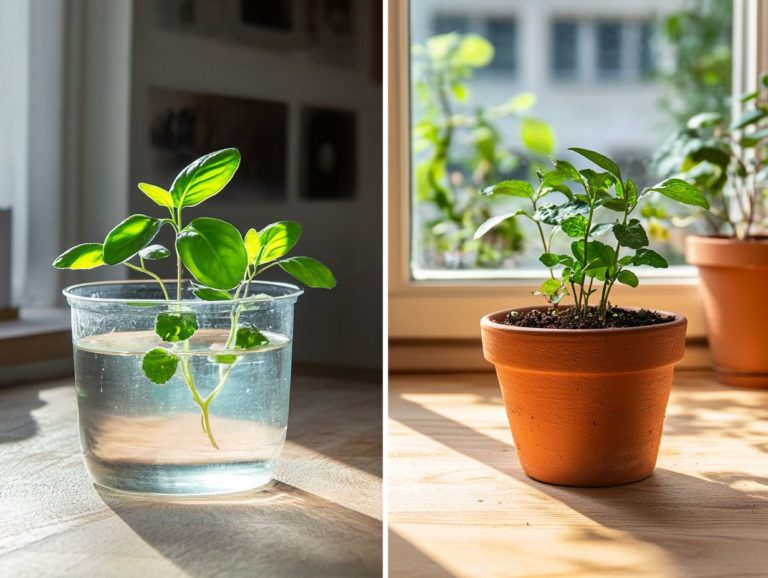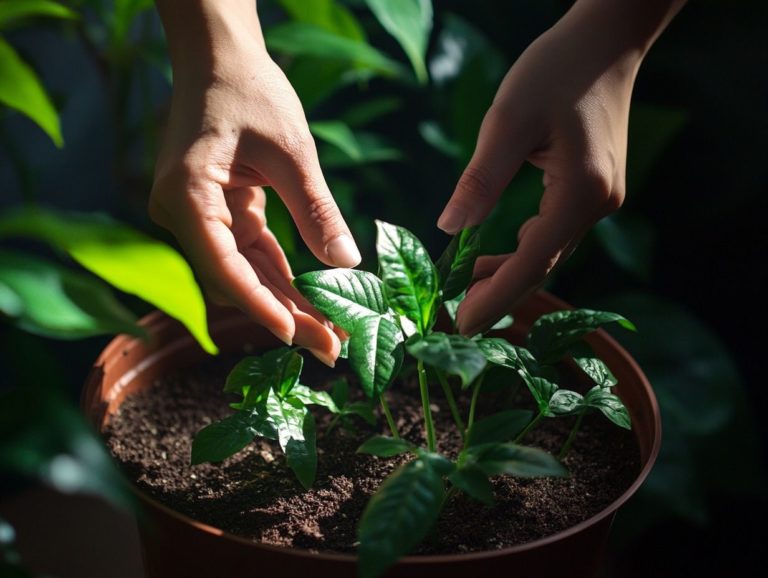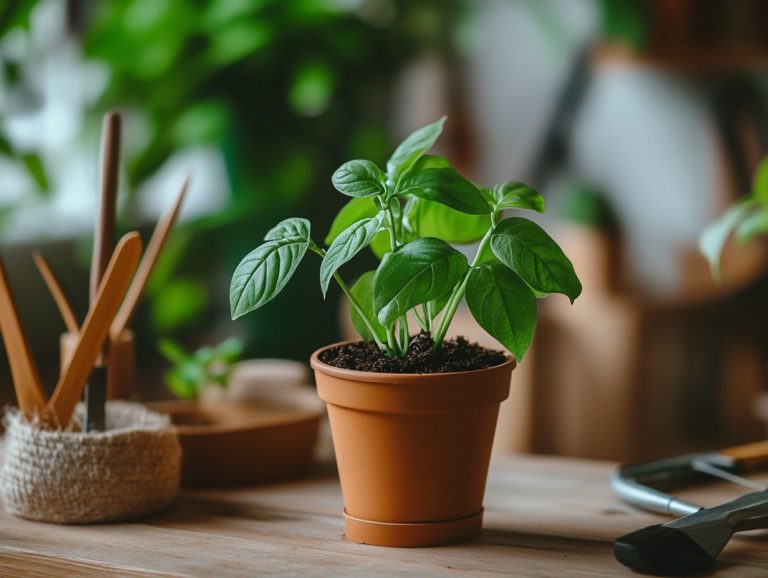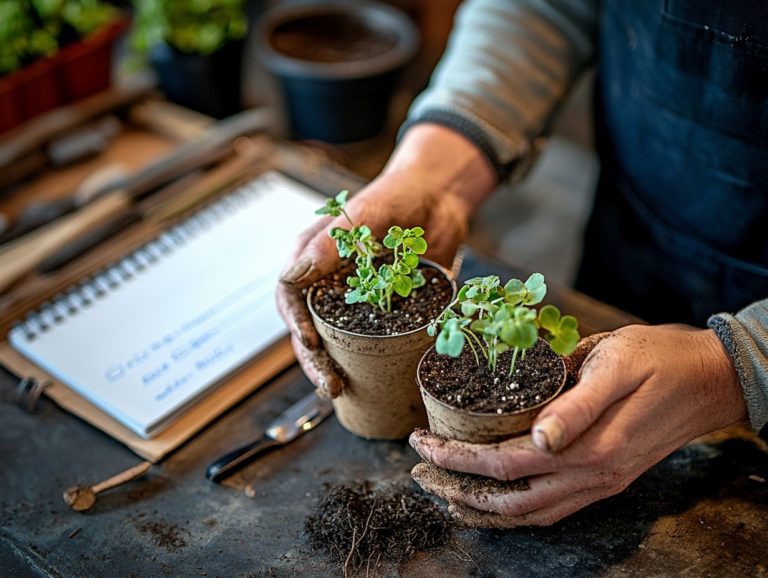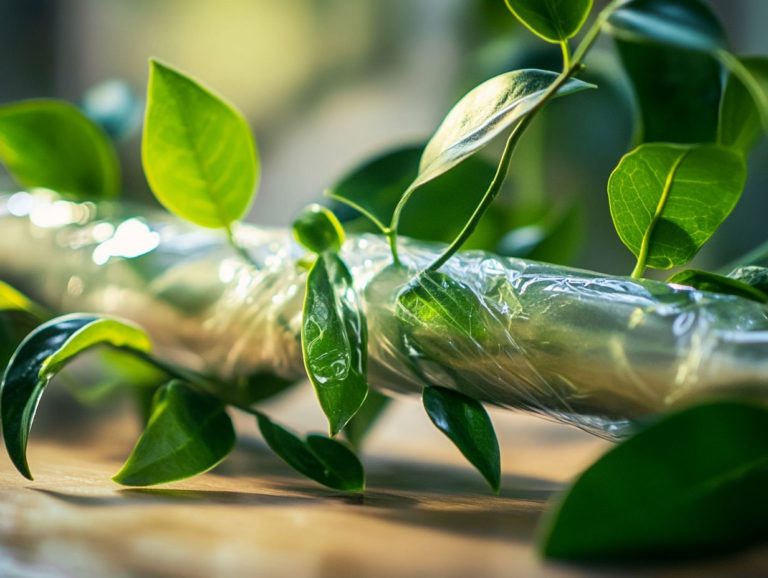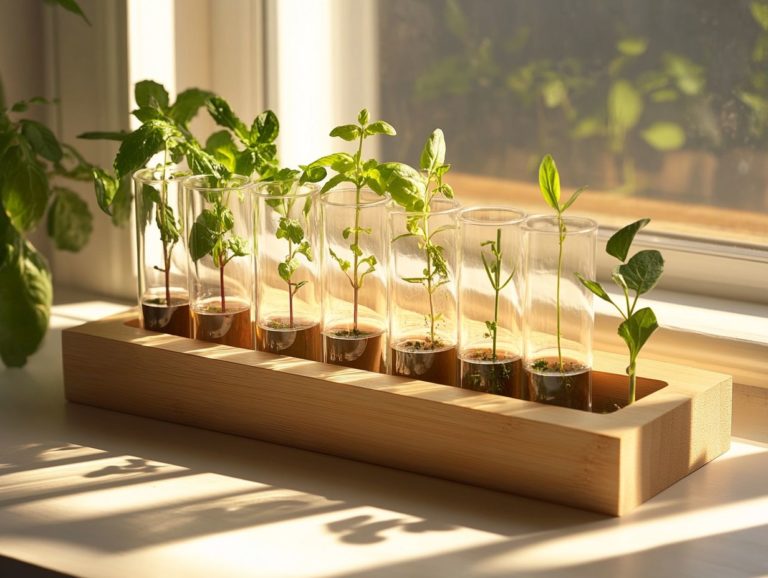How to Propagate Peperomia Plants
Propagation offers an exceptional opportunity to enhance your collection of Peperomia plants, celebrated for their striking foliage and remarkable resilience.
Get ready to explore exciting propagation methods that will grow your peperomia collection! This guide will cover various techniques, including leaf and stem cuttings, as well as division. You ll gain insight into the best times to propagate and how to select healthy specimens for optimal success.
Key steps involve preparing your cuttings and nurturing your new plants while also addressing common challenges such as pests and root rot. Dive into the journey of plant propagation and discover the joy of growing your own!
Contents
- Key Takeaways:
- Methods of Propagation
- Choosing the Right Time and Plant
- Steps for Propagating Peperomia Plants
- Troubleshooting Common Issues
- Frequently Asked Questions
- 1. How do I propagate Peperomia plants?
- 2. When is the best time to propagate Peperomia plants?
- 3. What type of soil should I use for propagating Peperomia plants?
- 4. Do I need to use rooting hormone when propagating Peperomia plants?
- 5. How often should I water my propagated Peperomia plants to ensure healthy plant growth?
- 6. Can I propagate Peperomia plants in water, and what are the best propagation methods?
Key Takeaways:
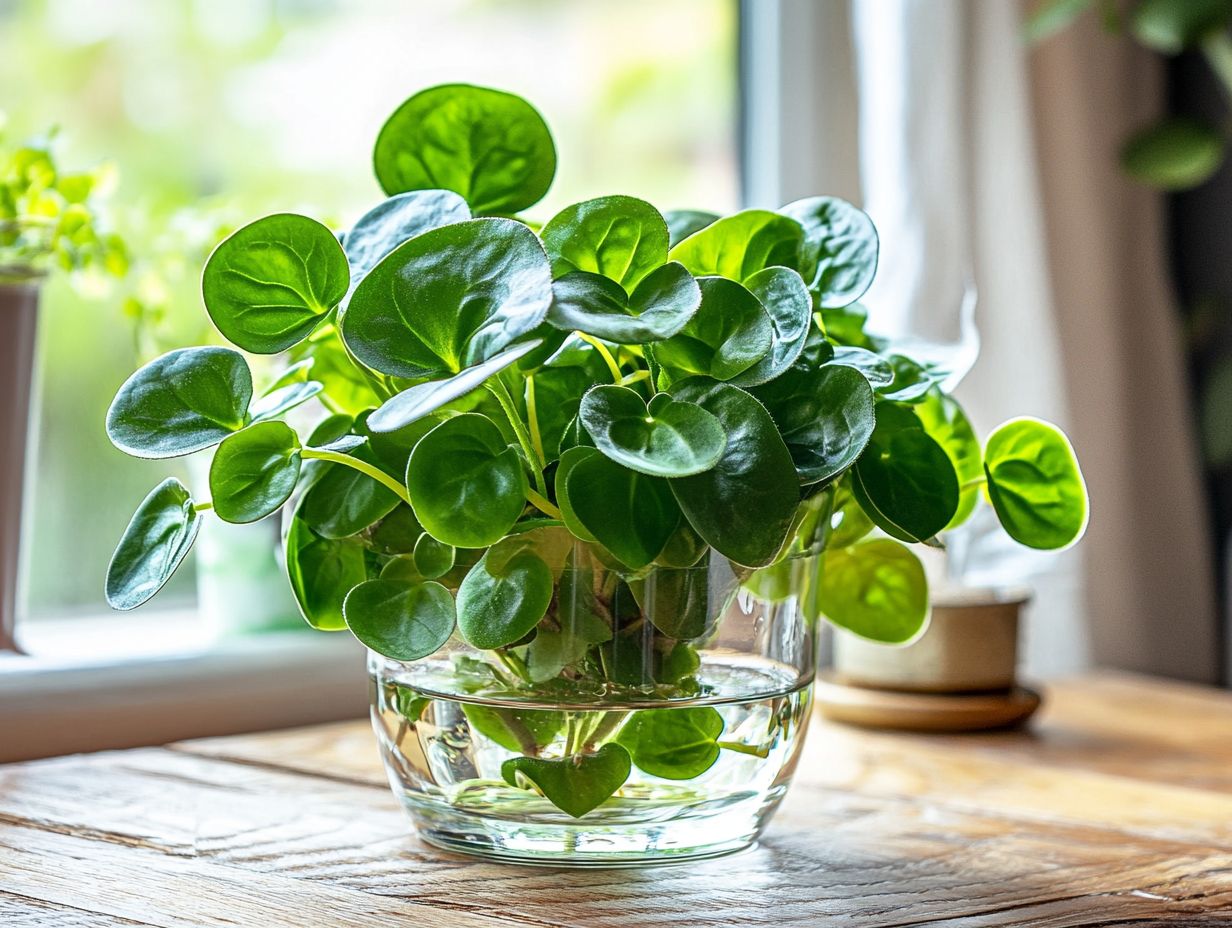
- Proper timing and choosing healthy plants are crucial for successful propagation of peperomia plants.
- Leaf and stem cuttings are the most common and effective methods of propagation for peperomia plants.
- Regular monitoring and care, as well as addressing common issues like pests and root rot, are important for the growth and health of new peperomia plants.
What is Propagation?
Propagation is your ticket to growing new plants from existing ones, making it easier than ever to grow healthy peperomia and other tropical plants. This practice is fundamental in gardening, allowing you to multiply your cherished houseplants think adorable baby rubber plants and charming radiator plants ensuring your indoor garden thrives.
By grasping the art of propagation, you not only enhance your variety of plants but also embrace sustainable gardening practices. It opens up a world of exploration where you can experiment with various methods, like leaf cuttings and stem cuttings, leading to healthier additions to your collection.
Each technique is like a key to a vibrant green sanctuary, enabling you to craft a personalized indoor landscape. Leaf cuttings? Just snip a healthy leaf and watch it develop roots. Stem cuttings? Simply take a segment of the stem and place it in compost or water. These simple methods give you the power to expand your plant family without breaking the bank.
Focusing on peperomia helps you contribute to a variety of plants, nurturing not just your garden but the broader ecosystem as well. Engaging in propagation, such as how to propagate spider plants, ensures these stunning species remain accessible for future generations, deepening your appreciation for the artistry of gardening.
Methods of Propagation
You have a wealth of effective methods at your disposal for propagating plants, allowing you to cultivate new specimens from your existing collection and ensure a thriving supply of healthy peperomia and other varieties.
The key techniques include leaf cuttings, stem cuttings, and division, each presenting unique advantages tailored to specific plant species and your gardening environment.
Equipping yourself with the right propagation tools, such as clean knives and pruning shears, is essential for fostering successful root growth and establishing robust new plants. Pay attention to factors like well-draining soil and humidity to enhance your plants health.
Leaf Cutting
Leaf cutting is an elegant and straightforward propagation method that gives you the power to cultivate new plants from healthy peperomia or succulent leaves. This technique is easily accessible, whether you’re a novice or a seasoned plant enthusiast.
Begin by taking a clean leaf cutting with a leaf node, applying rooting hormone—a substance that helps stimulate root growth—to encourage root development, and placing it in well-draining soil or even water for propagation. For detailed guidance on this process, check out how to propagate your favorite houseplants. With the right conditions, such as adequate humidity and light, your leaf cuttings can flourish, transforming into thriving new plants.
Select only the healthiest leaves; remember, damaged or diseased ones can thwart your efforts at successful propagation. Use sterilized scissors to carefully trim the chosen leaf, ensuring a clean cut.
Next, dust the cut edge with rooting hormone, which promotes robust root development and helps prevent rot. Place the cutting in a pot filled with moist, well-draining soil or a glass of water, ensuring it sits securely.
Keep a keen eye on humidity and light levels, as these elements significantly impact the rooting process. Stay vigilant for potential challenges, such as fungal growth or insufficient moisture, and adjust your environment as needed perhaps by enhancing air circulation or gently misting the soil to ensure your propagation journey is a resounding success.
Stem Cutting
Stem cutting is an effective propagation method that allows you to take a section of stem from a healthy plant and encourage it to develop roots. This leads to the growth of new peperomia plants. This technique is a fantastic way to create multiple new plants from a single parent plant.
To achieve successful root growth, it s essential to prepare your cuttings properly. Select healthy stems with leaf nodes, provide the right environment, and use well-drained potting soil or water for propagation.
- Start by choosing a healthy stem, free from any signs of disease. Ideally, it should measure about four to six inches long and have a few leaves.
- After taking the cutting, remove any excess foliage. This helps prevent rot and directs energy towards root development.
Once you have your cuttings, get them into a warm, humid environment right away think greenhouse vibes or a cozy plastic bag to lock in moisture. Keep a close eye on them; yellowing leaves or mushy stems signal that something might be wrong. Troubleshooting environmental factors like light and humidity levels will ensure you create optimal conditions for rooting.
Division
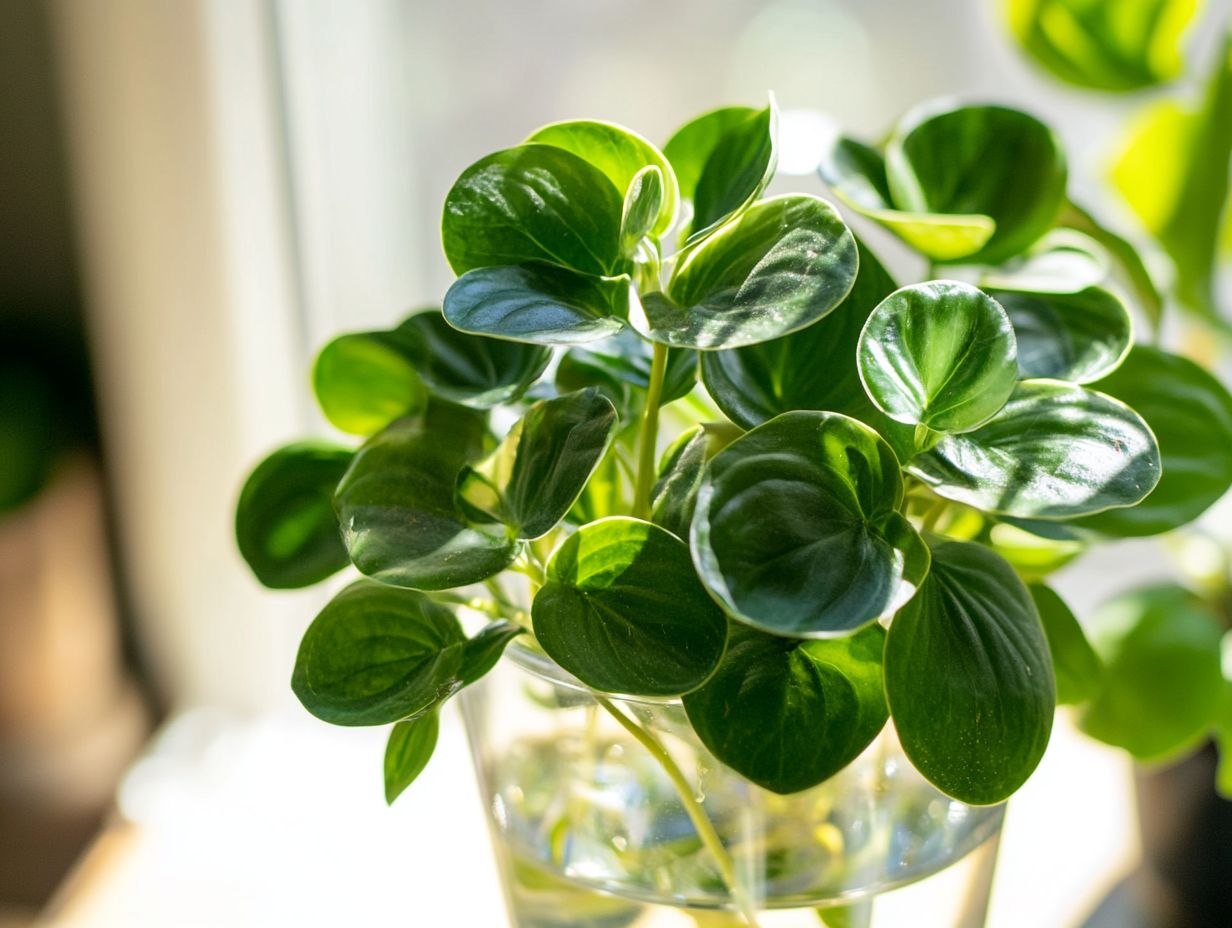
Division is a simple yet effective propagation method that involves taking a mature plant and splitting it into smaller sections. Each section can grow into a vibrant new plant. This technique is perfect for various species, including peperomia, and is especially useful in container gardening, which means growing plants in pots or other containers.
By ensuring that each division has roots and healthy foliage, you set the stage for new plants to thrive in similar growing conditions.
Timing plays a critical role in successful division, with spring or early summer often being the best times. During this active growing period, assess the parent plant and select sections that feature multiple stems and a strong root system. These are your best bets for survival.
After making your divisions, the nurturing phase begins. Place your newly propagated plants in well-draining soil and give them a cozy spot in lightly shaded areas until they acclimate. Keep an eye on moisture levels to prevent stress and encourage healthy growth as they establish their new roots.
Choosing the Right Time and Plant
Selecting the perfect time and plant for propagation is crucial for achieving success in your gardening endeavors. Spring and summer are the perfect times to start propagating, especially for tropical varieties like peperomia. During these months, your plants will enjoy optimal growth conditions, which fosters robust root development and encourages new growth.
Choosing healthy plants for propagation is vital; their vigor significantly impacts the success rate of your methods. This enhances the likelihood that your gardening efforts will result in thriving new plants that flourish beautifully in the right light conditions.
Best Time for Propagation
The best times for propagation usually fall in the spring and summer. This is when plants are in their growth spurt, ensuring the highest success rates for establishing new plants. The warmth and increased light during these seasons foster robust root development and vibrant new foliage, making it easier for you to achieve thriving plants from cuttings.
Understanding the unique growth patterns of various plant species can refine your timing decisions. Many perennial plants surge after their winter slumber, indicating a perfect opportunity for propagation. Look for signs of health, such as lush leaves and sturdy stems, which show that a plant is ready to share its vitality.
Monitoring bloom cycles can further guide your propagation efforts since many flowering plants thrive post-bloom. With these insights, you can elevate the propagation process from a simple task to a strategic endeavor, leading to stunning results in your garden.
In conclusion, propagating plants can be a rewarding experience that allows you to expand your collection. By following the right methods and timing, you can create many new plants that will thrive beautifully in your home.
Healthy Plants for Propagation
Selecting healthy plants for propagation is crucial for achieving successful outcomes. The initial health of the plants directly influences both the propagation process and the vitality of the new plants.
Take a moment to assess various characteristics. Look for vibrant foliage, sturdy stems, and strong roots. It’s also important to inspect for any visible pests, such as aphids or spider mites, and diseases like powdery mildew, which could jeopardize your propagation efforts.
Once you’ve identified suitable candidates, prepare these plants by pruning away dead leaves and ensuring they are well-watered. This careful preparation helps your plants grow well and increases their chances of thriving after you take your cuttings.
Steps for Propagating Peperomia Plants
Get ready for an exciting adventure in propagating peperomia plants! This journey involves straightforward steps that promise successful root growth and the establishment of new tropical plants. As an enthusiast, you ll find this process both enjoyable and rewarding.
It all starts with gathering essential materials clean knives, pots filled with well-draining soil, and rooting hormone at the ready.
By adhering to a structured care guide, you ll prepare your cuttings with precision, root them effectively, and create the ideal conditions for growth. In doing so, you’ll cultivate vibrant new specimens that enhance your indoor plant design and elevate your overall gardening success.
Embrace this venture and watch your green thumb flourish.
Preparing the Cuttings
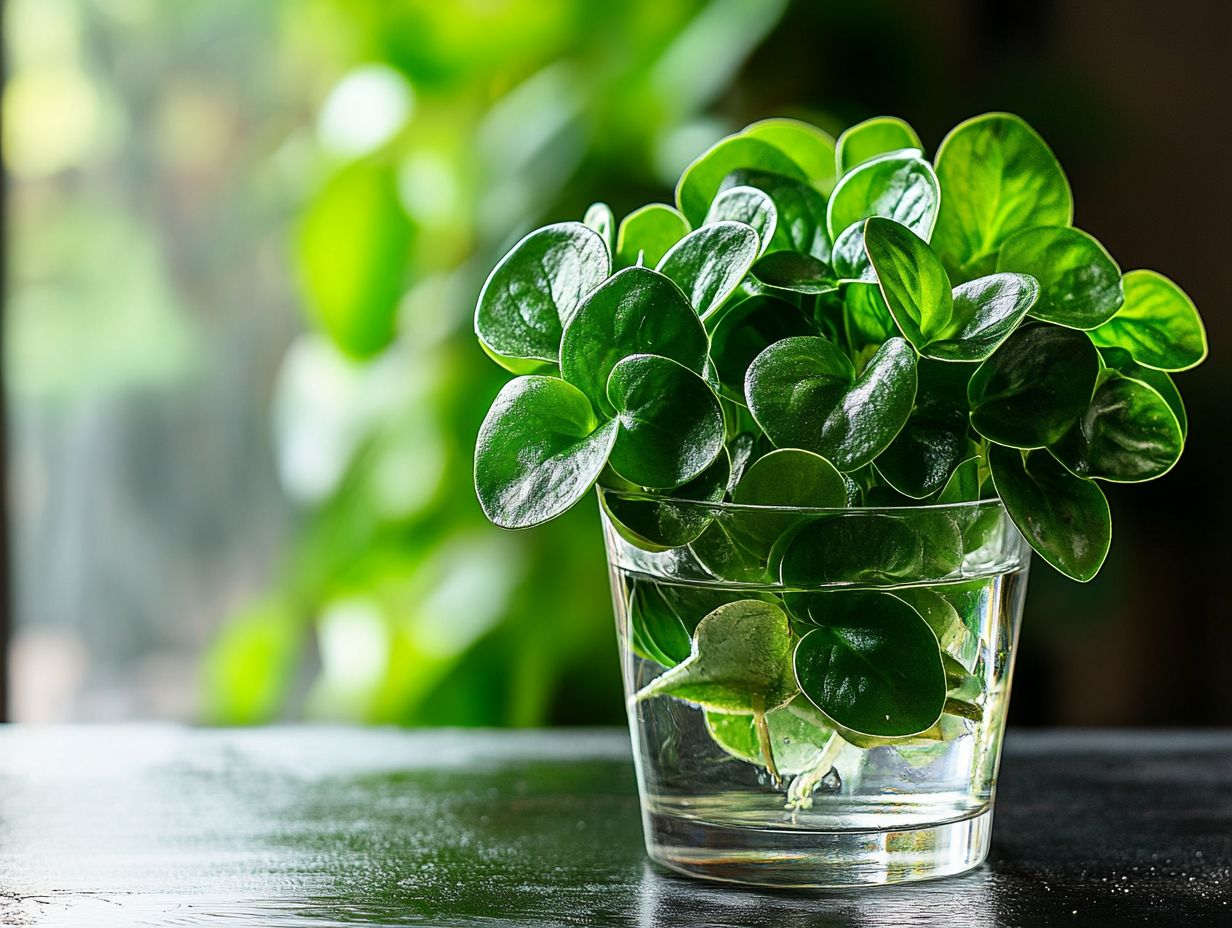
Preparing your cuttings is a pivotal step in the propagation journey. This step sets the stage for successful root growth and thriving new plants. Start by selecting a healthy peperomia plant and use a clean knife to take cuttings that include at least one leaf node, the part of the stem where leaves attach. Using the right tools ensures that your cuttings are prepared with precision, minimizing the risk of damage and promoting effective propagation.
As you move forward, pay attention to the size of your cuttings. Aim for segments that are around three to six inches long. This length strikes an optimal balance between stability and the potential for vigorous root development.
Applying rooting hormone can significantly boost your chances of successful propagation by stimulating root formation. Be sure to dip the cut end into the hormone, allowing it to absorb thoroughly.
Finally, remember that maintaining the right moisture levels is crucial. Providing a humid environment keeps your cuttings hydrated as they establish their roots, an important aspect of plant care.
Rooting the Cuttings
Rooting your cuttings effectively is essential for establishing new, healthy peperomia plants. This process demands your careful attention to environmental conditions. Once you ve prepared the cuttings, place them in a container with light, airy soil or even water for propagation. Here, humidity levels and light conditions are pivotal in promoting robust root growth.
To achieve successful propagation, consider the right method based on your personal preference and available resources. If you choose water propagation, opting for a clear container allows you to easily observe root development and maintain the right water level. For those interested in indoor plants, you can learn more about how to propagate ZZ plants. On the other hand, soil propagation typically requires moister soil, which can often yield stronger roots.
Maintaining high humidity is straightforward. Using a plastic bag or a humidity dome keeps moisture levels stable and encourages healthy root production in your mini greenhouse.
Position your cuttings in bright, indirect light to prevent them from becoming leggy. This is key in plant care for healthy indoor plants. Remember to wait until your cuttings have established a solid root system before potting them, ensuring they can thrive in their new environment.
Caring for Your New Plants
Taking care of your new Peperomia plants is crucial for their growth and health. Keep a close eye on soil moisture and humidity.
Once the roots are established, ensure well-drained soil and the right amount of water to avoid overwatering or root rot. Providing the right light conditions will help your plants thrive.
Watch for signs of stress, like yellowing leaves or wilting, which can indicate insufficient light or watering.
Check soil moisture regularly by feeling the soil with your finger or using a moisture meter a tool to check soil dampness. These plants thrive in moderate humidity, so consider using a humidity tray or misting them occasionally.
Adjust your care based on how your plants respond to cultivate an environment that encourages flourishing growth.
Troubleshooting Common Issues
Protect your plants now to ensure they thrive! Troubleshooting common issues during propagation is vital for maintaining plant health.
Stay vigilant about potential challenges such as pests, diseases, and root rot, as these can impact your efforts to grow healthy plants.
Identify issues early and implement effective solutions to protect your propagated plants and encourage their healthy development.
Preventing and Addressing Pests
Prevent pests to keep your Peperomia thriving. Regular inspections for signs of pests like discolored leaves or sticky residue are essential for catching issues early.
- Maintain the right humidity and light conditions to deter pests.
- Rotate plant locations to disrupt pest activity.
- Use neem oil or insecticidal soaps as safe treatments for infestations.
- Keep your growing area clean and free of debris to minimize hiding spots for pests.
Engage in regular health assessments of your plants to identify pest issues sooner and promote overall vigor.
Dealing with Root Rot

Root rot is a challenge every gardener faces. Act quickly to save your healthy plants like Peperomia!
This issue often arises from overwatering and poor drainage. Keep a close watch on soil moisture to reduce the risk of root rot.
Employing preventive measures like using well-draining soil and ensuring proper potting conditions is key to nurturing your newly propagated plants.
Recognizing the signs of root rot early is essential. Look for yellowing leaves, wilting plants, and unpleasant smells from the soil.
In these cases, check how you water your plants. Adjust the frequency and ensure your pots have drainage holes to create a healthier environment.
Choose soil that retains moisture while draining excess to protect your greenery effectively.
Check your plant roots often to catch problems early. Look for darkened or mushy areas that may signal root rot or poor drainage. This proactive approach allows for swift action removing affected plants from their pots and treating them to restore health.
Frequently Asked Questions
1. How do I propagate Peperomia plants?
To propagate Peperomia, use healthy stem or leaf cuttings. Simply place them in water or moist, well-draining soil.
2. When is the best time to propagate Peperomia plants?
The best time to propagate Peperomia is during the spring or summer when the plants are actively growing.
3. What type of soil should I use for propagating Peperomia plants?
Peperomia plants prefer well-draining soil. A mixture of potting soil and perlite or sand works well. Adding organic matter like peat moss or compost provides the nutrients needed for new roots.
4. Do I need to use rooting hormone when propagating Peperomia plants?
Rooting hormone can speed up the rooting process, but it s not necessary. Peperomia can grow roots easily without it.
5. How often should I water my propagated Peperomia plants to ensure healthy plant growth?
Water your propagated Peperomia regularly to keep the soil moist but not soggy. Check the soil every few days and water when the top inch feels dry.
6. Can I propagate Peperomia plants in water, and what are the best propagation methods?
Yes, you can propagate Peperomia in water. Place the cuttings in a jar or container filled with water, ensuring the leaves are not submerged. Change the water every few days to prevent bacteria, and transfer the cuttings to soil once new roots form.

